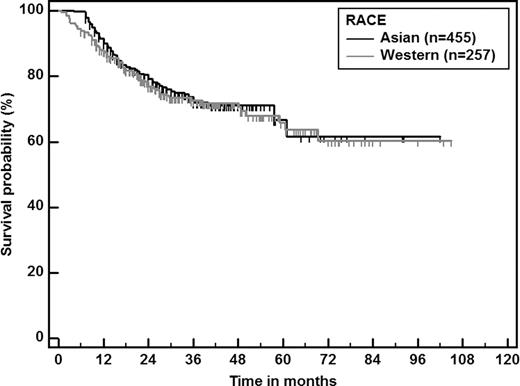Abstract
Abstract 2665
Little is known on the racial differences in characteristics and outcomes of patients with a diagnosis with diffuse large B-cell lymphoma (DLBCL) treated with rituximab-containing regimens. The aim of this retrospective study is to compare the clinicopathological characteristics, prognostic factors and outcomes of Asian and Western patients with a diagnosis of de novo DLBCL treated with rituximab, cyclophosphamide, doxorubicin, vincristine and prednisone (R-CHOP).
Patients and Methods: Patient-level data was collected from 8 centers (USA, Italy, Sweden, Finland, Croatia, Japan, Korea and China). This study was approved by the Institutional Review Board at each of the participant centers. All patients were diagnosed with de novo DLBCL and treated with R-CHOP administered every 3 weeks. HIV-positive and primary brain DLBCL were excluded. The requested clinical data included age, sex, performance status, lactate dehydrogenase (LDH) levels, number of extranodal sites, clinical stage, expression of CD10, BCL6 and MUM1/IRF4, response to chemotherapy, outcome and overall survival (OS). Patients were divided in Asian and Western, according to the country of report. Comparison between groups was performed with Mann-Whitney and Chi square tests for continuous and categorical variables, respectively. Univariate survival curves were estimated using the Kaplan-Meier method and compared using the log-rank test. Multivariate analysis was performed using the Cox proportional-hazard regression test. P-values of <0.05 were considered statistically significant.
A total of 712 patients, 455 Asian and 257 Western patients were included in this study. Western patients were more likely to present with elevated LDH levels (70% vs. 48%; p<0.001), advance clinical stage (58% vs. 49%; p=0.02) and a non-germinal center immunohistochemical profile (53% vs. 43%; p=0.01). Additionally, Western patients were more likely to present with low risk IPI scores (p=0.003 for trend), and had higher complete response (CR) rates (91% vs. 76%; p<0.001). There were no statistical differences between the 2 groups on age at diagnosis, sex distribution, ECOG performance status, number of extranodal sites, overall response rates and proportion of deaths. After a median follow-up of 36 months, there was no difference in median overall survival (OS; not reached in both groups) or estimated 5-year OS (66% vs. 62%; p=0.67) (Figure). In the univariate analyses, ECOG >1, elevated LDH levels and advanced clinical stage were significantly associated with a worse median OS in Westerners (p<0.01 each factor) while ECOG >1, >1 extranodal sites and advanced clinical stage were significant adverse factors for Asians (p<0.01 each factor). In the multivariate analyses, ECOG >1 and advanced clinical stage were independent prognostic factors associated with a worse median OS in Westerners and Asians (p<0.01, p=0.03, and p<0.01, p<0.01, respectively). Elevated LDH level was an adverse independent prognostic factor for Western patients only (p=0.04).
Asian and Western patients with de novo DLBCL present with distinct clinical and pathological characteristics, and although the CR rate to standard R-CHOP was higher in Westerners than in Asians, the final outcome, prognostic factors and median and 5-year OS rates are similar in both populations.
Castillo:GlaxoSmithKline: Research Funding; Millennium Pharmaceuticals: Research Funding.
Author notes
Asterisk with author names denotes non-ASH members.


This feature is available to Subscribers Only
Sign In or Create an Account Close Modal